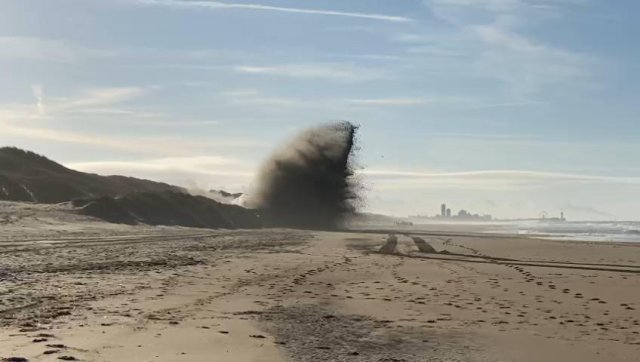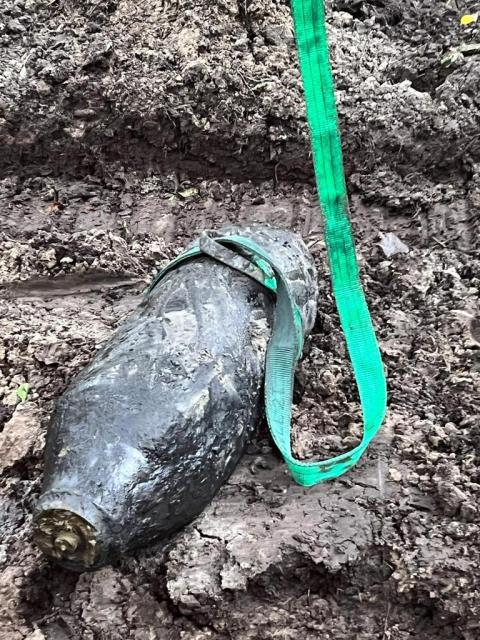Risk map of unexploded bombs
NGE risk map
The municipality of Wassenaar has a so-called bomb map. This Map is officially called the unexploded explosives (NGE) risk map. Using the Map , everyone can see where in Wassenaar there is a risk of finding unexploded explosives in the (water) soil. Among other things, the Map ensures that excavation and construction work can take place more safely. You can read more about this on this page.
Explosive remnants of war (unexploded ordnance)
During World War II, minefields were laid in large parts of the Netherlands and shelling and bombing took place. An unknown number of explosives failed to detonate and remained in the (water) soil. Many unused explosives were also dumped after the war by being buried or thrown into the water. Therefore, Explosive Remnants of War (OO), formerly called Non-Detonated Conventional Explosives (NGCE), may still be in the ground and on the water bottom. Even if they have been in the ground for some time, these explosives could still explode.

Small chance of accidents explosive remnants of war
In practice, accidents involving explosive remnants of war almost never happen. There is very little chance that leftover World War II explosives will spontaneously explode. Contractors are also required to conduct research on explosive remnants of war before work is carried out in high-risk areas. This is stated, among other things, in the Occupational Health and Safety Act. If a bomb is found during the investigation, it can be safely removed by experts from the Explosives Clearing Service of Defense (EOD). This special team of experts thus helps prevent accidents during the work. In some cases, it may be found that a bomb found does not pose a risk during the work or use of a site. In that case, this bomb will not be removed.

Wassenaar during World War II
During World War II, fighting took place on land in Wassenaar, particularly in the dune area. For this reason, there are also a number of areas in Wassenaar where bombs may have been dumped or grenades may be found. V-weapons were also stored in two areas in Wassenaar. These areas have been bombed many times with aircraft bombs. Sometimes these bombs did not explode on impact. Therefore, aircraft bombs can still be found in these areas, usually at a depth of a few meters. Also, part of the beach area was shelled with incendiary bombs from the air during World War II.
The current situation in Wassenaar
The events during World War II were extensively researched and Map during the preparation of the NGE risk map. Based on this historical research, risk areas have been designated on the Map of Wassenaar. This takes into account explosives that have already been found and removed. The Map was prepared in 2018 and updated in 2022 based on the latest historical data and risk calculation techniques. The risk areas for different types of explosive remnants of war are clearly marked on the Map.
Guide: instructions for use NGE risk map
In our fact sheet and handbook you can read more information about what you can do if you find an explosive. You can also read what to do if you want to carry out work (or have work carried out) in an area with explosives.
What to do about:
Finding an explosive
- Stay away from the explosive, do not touch it or take it with you.
- Stop all work in the immediate area.
- Don't go looking at the explosive again.
- Alert the police immediately via the emergency number 112. Even if you are in doubt whether it is an explosive device. The police will estimate whether the Explosives Ordnance Disposal Service (EOD) should be called in.
- Health make sure bystanders stay away.
Magnet Fishing
- Magnet fishing is prohibited in the municipality of Wassenaar based on the General Municipal Ordinance Article 5:30a.
- While magnet fishing, do you suspect you have an explosive on your magnet?
- Do not remove the object from the magnet. Hang it back in the water. Rusty metal can break. Modern hand grenades or weapons may have DNA on them. That is best preserved in water.
- Call the police using the emergency number 112. The police estimate whether the Explosives Ordnance Disposal Service (EOD) should be called in.
- Do not leave the found object on the street or take it home.
- Stay with the object until the police arrive.
Nationwide approach to explosive remnants of war
- The Explosieven Opruimingsdienst Defensie (EOD) is responsible for clearing explosives in the Netherlands.
- In order to work safely in soil, it is mandatory to carry out research for explosive remnants of war. This is stipulated in the Working Conditions Regulations; Section 4.2b. Detection of explosive remnants of war. This also includes the national quality standard: Certification Scheme for Detecting Explosive Remains of War (CS-OOO). In addition, a quality standard has been established by the Safe Handling of Explosive Substances Foundation (VOMES) for Historical Preliminary Research and Risk Analysis in the Certification Scheme for Preliminary Research and Risk Analysis Explosive Remains of War (CS-VROO-01).
- Under the Municipal Law, the mayor is the authority for Public Order and Safety (OOV). Notify the mayor when a search is going to take place at a location. Do you want to start targeted digging for the purpose of searching for OO? Then the mayor must approve the execution of investigative work within the municipal boundaries. This is done by a signature of the work. We therefore request that the associated project plan and the preceding investigations be reviewed in terms of content by a competent person familiar with OO and/or an independent body.
- Do you want to start work in an area where there may be bombs? If so, please contact the municipality of Wassenaar.
Sources: Explosive remnants of war | Signals Environment and Health(external link)